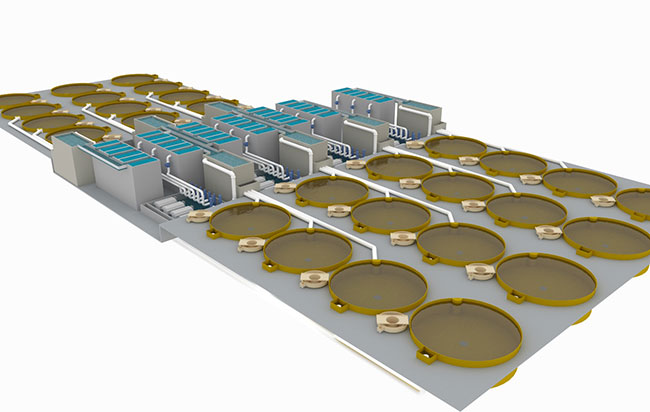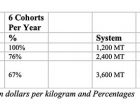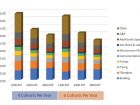
Features
Management
Research
Sustainability
Show me the money
Economies of scale for land-based recirculating aquaculture systems
February 4, 2020 By Laura Bailey and Brian Vinci

Land-based recirculating aquaculture systems (RAS) are becoming more common for the production of market-sized salmonids. A major obstacle to implementing commercial-scale RAS is the large upfront capital cost. This study analyzed the capital cost of land-based RAS at three annual production levels and determined the impact of scale on capital costs. Additionally, we analyzed the impact of facility utilization, or the number of cohorts per year, on capital cost.
Six concept-level RAS facility designs were developed to produce 1,200, 2,400, or 3,600 tons of Atlantic salmon. Each production level included a design to accommodate six cohorts per year and a design to accommodate four cohorts per year. All designs were based on identical bio planning, which included identical fish growth at each life-stage and determining all locations and movements of fish throughout the production cycle. The concept level designs were used to develop capital cost estimates based on construction industry standard data and prices provided by aquaculture vendors.
Concept design development
Concept designs were comprised of RAS with dual-drain culture tanks, radial flow settling, microscreen filtration, fluidized sand biofiltration, cascade aeration for carbon dioxide stripping, low head oxygenation for oxygen addition, and water chilling. Additionally, ozonation was included for all grow-out systems. Bio planning for the engineering designs were based on data from The Conservation Fund’s Freshwater Institute. For example, the following feed conversion ratios were used: Fry, 0.85; smolt, 0.90; pre-grow-out, 1.0 and grow-out, 1.1. Maximum biomass density of 85 kg/m3 was used for all RAS. The overall mortality rate used was 28 percent, which included two cull events of 10 per cent each.
Each fish production scenario assumed maintenance of the following water quality conditions: total suspended solids <5 mg/L, dissolved oxygen of 100 percent saturation, total ammonia nitrogen <1.3 mg/l, dissolved carbon dioxide between 10-20 mg/l, and nitrate-nitrogen <80 mg/l. Concept designs of facilities were planned to grow market-size salmon of 4.5 kg from egg. All facilities included finishing/depuration systems. The number of tanks and RAS used for each facility design differed depending on the standing biomass and the estimated density.
Cost estimates
Standard engineering methodology was used to develop capital cost estimates for each of the six facility designs. Cost estimates have three main parts: building cost, including basic build-out, backup generator, and feed storage; RAS equipment and installation, including equipment and labor for each of the rearing stages; and additional costs, such as overhead and profit, engineering, construction management, and 10 percent contingency. Cost estimates were intended to be complete delivered project costs. The cost in dollars per kilogram of fish produced was used to compare the total cost between the different production sizes. The $/kg for all facility designs are shown on Table 1. The percentage column shows the scaling effect. The highest capital cost, 1,200 MT at four cohorts per year, is considered 100 percent and the other percentages are based off that value.
Results
Overall, the capital cost per unit of salmon produced decreased as the size of the facility increased. For instance, the cost difference between the 3,600 MT and the 1,200 MT was almost $14/kg. Additionally, RAS facilities producing six cohorts per year resulted in capital cost savings ($/kg) compared to facilities growing four cohorts per year. The 3,600 MT at six cohorts per year is almost $3/kg less than the 3,600 MT at four cohorts per year.
We broke down the capital cost estimates into major expense categories, as shown in Table 1. Major line items that contribute to the total cost of the systems are the building, fiberglass, piping, recirculating pumps, and microscreen filters. We found the building costs are affected by both scaling and facility utilization. For the facilities with six cohorts per year, the building costs were almost $1/kg less than the systems with four cohorts per year and the building costs were about $1.50 per kg less for the 3,600 MT designs compared to the 1,200 MT designs.
Another major capital expense was tank construction, low head oxygenators, CO2 strippers, radial flow settlers, and other RAS equipment. We found fiberglass to be less affected by facility utilization, but more affected by scaling. The fiberglass cost per kg for the six cohorts per year model is relatively close to the four cohorts per year. For piping, the unit cost difference between the six cohorts per year and four cohorts per year system is minimal. The piping cost appears to be impacted by scaling, especially between the 2,400 MT facility and the 1,200 MT facility. The pump costs per kilogram were impacted by facility utilization differently than the other unit costs. The facility designs at 3,600 MT and 1,200 MT with six cohorts per year required more pumps in order to accommodate fish every two months, and as a result had higher costs compared to the 3,600 MT and 1,200 MT with four cohorts per year. In terms of scaling, the pump cost per kilogram decreases with the larger facilities.
We also compared the capital cost for the 2,400 MT concept design that is based on a fluidized sand biofilter (FSB) RAS to the capital cost of a 2,400 MT concept design that is based on a moving bed biofilter RAS. We found the cost per kilogram for 2,400 MT FSB concept design ($31.11/kg) was higher than the cost of the 2,400 MT MBBR design ($27.71/kg).
Conclusion
Results from this engineering analysis indicate that larger RAS facilities capable of producing more salmon per year and with bio plans designed to maximize tank space with a maximum number of cohorts resulted in a lower capital cost per kilogram of annual production. These results are not surprising; however, we found that scale and facility utilization affected expense items differently. For example, building costs were impacted by both scale and facility utilization, but costs for fiberglass, piping and pumps were primarily influenced by facility scale only.
Announcements for new land-based salmon farms include a range of annual production from 1,000 MT to 220,000 MT, with many at 5,000 MT. The capital cost for these projects are so large that finding savings and efficiencies is critical. This analysis indicates that designers can focus on the interplay between building and tank construction to best take advantage of economies of scale for reduced cost. Innovative solutions to maximize tank volume and minimize building size will have the greatest positive effect.
Laura Bailey is a project engineer with The Conservation Fund’s Freshwater Institute, and Brian Vinci is the director of the Freshwater Institute, based in Shepherdstown, West Virginia.
Print this page

